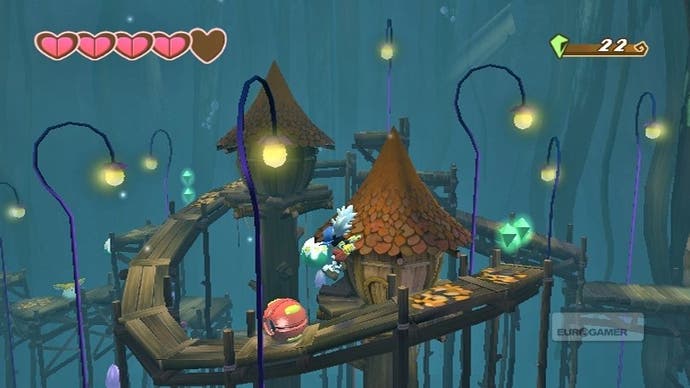Klonoa: Door to Phantomile
Do you remember the time?
Last year, Klonoa's publisher Namco Bandai sent its supporters a survey. "We are planning to remake one of our classic titles," it stated. "Would you be so kind as to answer a few questions to help guide the development?" The recipient was then required to fill in some straightforward details: "Age", "Gender", "Do you have or intend to buy a Wii?" and so on. Then the questions became more pointed and peculiar, asking, for example, that respondents register their excitement about the concept of a Wind Bullet (a ring-like device that "fires a short burst of wind, used to inflate your enemies").
Finally, the questionnaire presented two different character designs of the titular bipedal rabbit-cat himself. "Based on these two images", it then asked, "please rate the following design characteristics on a scale of one to five: Ears, Face, Clothing, Shoes and Lack of Hat". (The exact same order of criteria Eurogamer uses to choose a partner). Surely it was this final option that revealed the true purpose the survey, to finally settle a debate that had presumably raged for months between two precious designers: should the all-new Klonoa wear a hat or not? Well, that and the stuff about the Wind Bullet. It's very important to know what your customer thinks about the Wind Bullet…
In the end, the pro-hat designer won out (as well he should: if you owned a sweet-ass Pac-Man cap, why on earth would you ever leave the warren without it?). If Namco had had any more general doubts about resurrecting this minor star of the 32-bit era, they were evidently quashed by the positive response to their inimitable brand of research.
It's not surprising. Klonoa: Door to Phantomile was, on its original release in 1997, a cute, colourful and imaginative platform game, one that helped pioneer the 2.5D side-scrolling technique and whose influence can clearly be seen in contemporary heavyweights such as LittleBigPlanet. So despite one or two mediocre sequels, there still exists a good dose of nostalgic goodwill towards the charming character and the dream-world he roamed.

Time has done little to dull those charms. From the first touch, Klonoa feels like a crucial missing piece of the jigsaw of the Wii's library: a side-scrolling platform game with assured, grounded, tried-and-tested foundations. This is an orthodox game that wants nothing to do with innovation. You move, in general, from left to right, defeating enemies, scaling and descending platforms and collecting things before facing off against a boss character with a life bar and one or two repeating attack patterns.
Visually, it's a primary-colour paint-splat of art and design that's just the right side of saccharine. Its character designs are esoteric but somehow familiar, its animations are economic but effective, its exacting Japanese polish and pedigree are impeccable.
So far, so Miyamoto, you might think. But Klonoa's abilities and feel are quite different to those of the brothers Mario. While you can bounce on enemies' heads, the key move to master is that Wind Bullet, which allows you to grab hold of enemies. At this point you can either launch them at other enemies as a projectile weapon, or alternatively, use your captured prey for a double jump, bouncing off their heads in mid-air to gain extra height. As it's possible to fire the Wind Bullet again, during the upward projectile of a double jump, skilful players will be able to perform triple and, in the later stages of the game, even quadruple jumps to make their way to hard-to-reach places.

